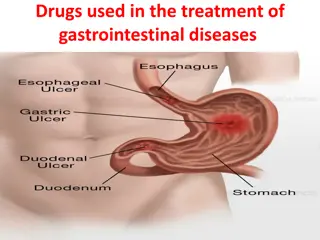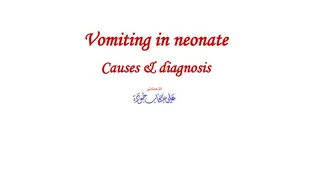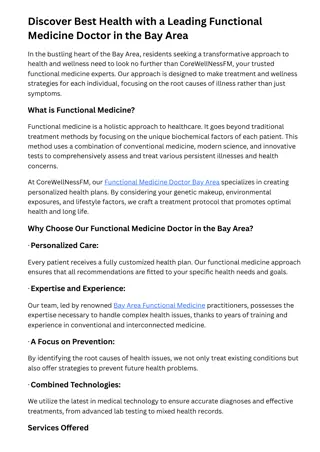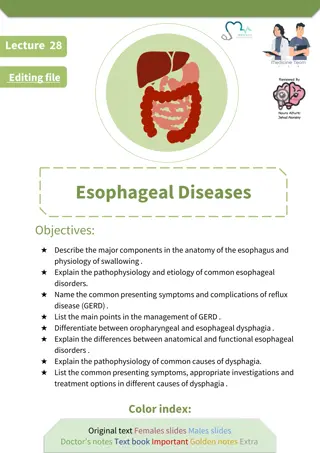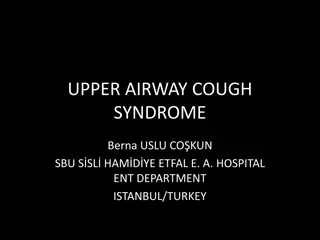
Understanding Gastroesophageal Reflux Disease (GERD) and its Complications
Learn about Gastroesophageal Reflux Disease (GERD), a condition where stomach acid flows back into the esophagus, causing irritation and potential complications. Discover the symptoms, causes, diagnosis, treatment options, and possible risks associated with GERD.
Uploaded on | 0 Views
Download Presentation

Please find below an Image/Link to download the presentation.
The content on the website is provided AS IS for your information and personal use only. It may not be sold, licensed, or shared on other websites without obtaining consent from the author. If you encounter any issues during the download, it is possible that the publisher has removed the file from their server.
You are allowed to download the files provided on this website for personal or commercial use, subject to the condition that they are used lawfully. All files are the property of their respective owners.
The content on the website is provided AS IS for your information and personal use only. It may not be sold, licensed, or shared on other websites without obtaining consent from the author.
E N D
Presentation Transcript
StudyMafia.Org Gastroesophageal Reflux Disease(GERD) Submitted To: Submitted By: Studymafia.org Studymafia.org
Table Contents Definition Introduction Symptoms of GERD Causes of GERD Complications of GERD Risk-Factors of GERD Diagnosis of GERD Treatment of GERD Conclusion 2
Definition Gastroesophageal reflux disease (GERD) occurs when stomach acid repeatedly flows back into the tube connecting your mouth and stomach (esophagus). 3
Introduction This backwash (acid reflux) can irritate the lining of your esophagus. Many people experience acid reflux from time to time. However, when acid reflux happens repeatedly over time, it can cause GERD. Most people are able to manage the discomfort of GERD with lifestyle changes and medications. And though it's uncommon, some may need surgery to ease symptoms. 4
Causes of GERD GERD is caused by frequent acid reflux or reflux of nonacidic content from the stomach. When you swallow, a circular band of muscle around the bottom of your esophagus (lower esophageal sphincter) relaxes to allow food and liquid to flow into your stomach. Then the sphincter closes again. 6
Causes of GERD If the sphincter does not relax as it should or it weakens, stomach acid can flow back into your esophagus. This constant backwash of acid irritates the lining of your esophagus, often causing it to become inflamed. 7
Complications of GERD Inflammation of the tissue in the esophagus (esophagitis). Stomach acid can break down tissue in the esophagus, causing inflammation, bleeding, and sometimes an open sore (ulcer). Esophagitis can cause pain and make swallowing difficult. 8
Classification of GERD Narrowing of the esophagus (esophageal stricture). Damage to the lower esophagus from stomach acid causes scar tissue to form. The scar tissue narrows the food pathway, leading to problems with swallowing. 9
Classification of GERD Precancerous changes to the esophagus (Barrett esophagus). Damage from acid can cause changes in the tissue lining the lower esophagus. These changes are associated with an increased risk of esophageal cancer. 10
Risk-Factors of GERD Conditions that can increase your risk of GERD include: Obesity Bulging of the top of the stomach up above the diaphragm (hiatal hernia) Pregnancy Connective tissue disorders, such as scleroderma Delayed stomach emptying 11
Risk-Factors of GERD Factors that can aggravate acid reflux include: Smoking Eating large meals or eating late at night Eating certain foods (triggers) such as fatty or fried foods Drinking certain beverages, such as alcohol or coffee Taking certain medications, such as aspirin 12
Diagnosis of GERD Upper endoscopy. Your doctor inserts a thin, flexible tube equipped with a light and camera (endoscope) down your throat. The endoscope helps your provider see inside your esophagus and stomach. Ambulatory acid (pH) probe test. A monitor is placed in your esophagus to identify when, and for how long, stomach acid regurgitates there. 13
Diagnosis of GERD X-ray of the upper digestive system. X-rays are taken after you drink a chalky liquid that coats and fills the inside lining of your digestive tract. Transnasal esophagoscopy. This test is done to look for any damage in your esophagus. Esophageal manometry. This test measures the rhythmic muscle contractions in your esophagus when you swallow. 14
Treatment of GERD Antacids that neutralize stomach acid. Antacids containing calcium carbonate, such as Mylanta, Rolaids and Tums, may provide quick relief. Medications to reduce acid production. These medications known as histamine (H-2) blockers include cimetidine (Tagamet HB), famotidine (Pepcid AC) and nizatidine (Axid AR). 15
Treatment of GERD Fundoplication. The surgeon wraps the top of your stomach around the lower esophageal sphincter, to tighten the muscle and prevent reflux. Fundoplication is usually done with a minimally invasive (laparoscopic) procedure 16
Treatment of GERD LINX device. A ring of tiny magnetic beads is wrapped around the junction of the stomach and esophagus. The magnetic attraction between the beads is strong enough to keep the junction closed to refluxing acid, but weak enough to allow food to pass through 17
Treatment of GERD Transoral incisionless fundoplication (TIF). This new procedure involves tightening the lower esophageal sphincter by creating a partial wrap around the lower esophagus using polypropylene fasteners. 18
Conclusion Gastroesophageal reflux disease (GERD) occurs when stomach acid repeatedly flows back into the tube connecting your mouth and stomach (esophagus). This (acid reflux) can irritate the lining of your esophagus. Many people experience acid reflux from time to time. 20
References Google.com Wikipedia.org Studymafia.org Slidespanda.com
Thanks To StudyMafia.org





